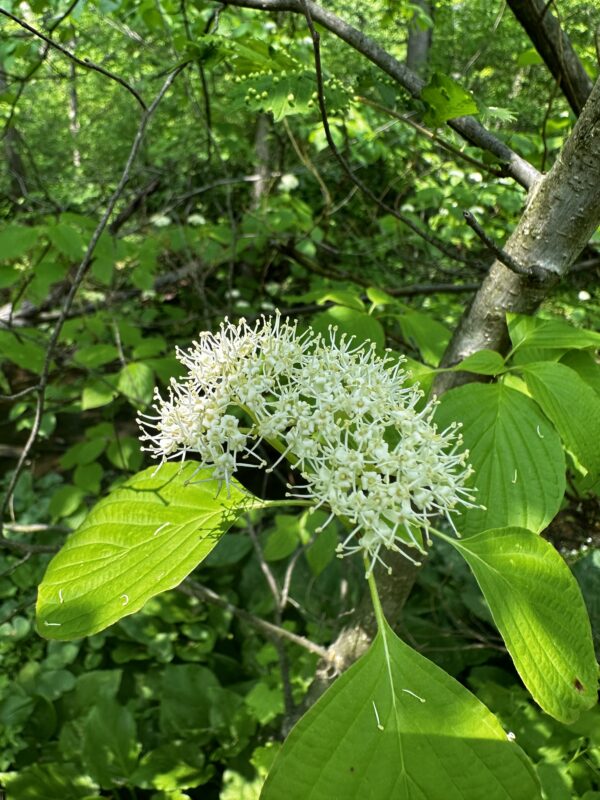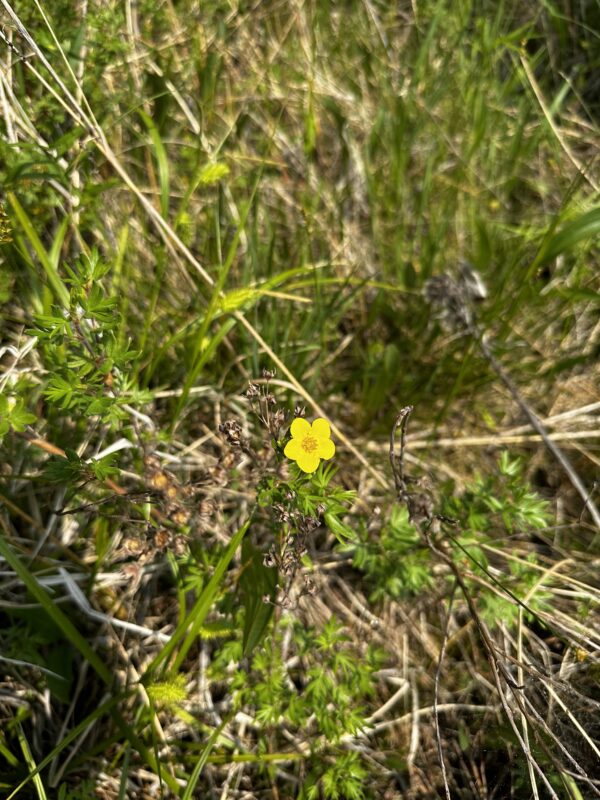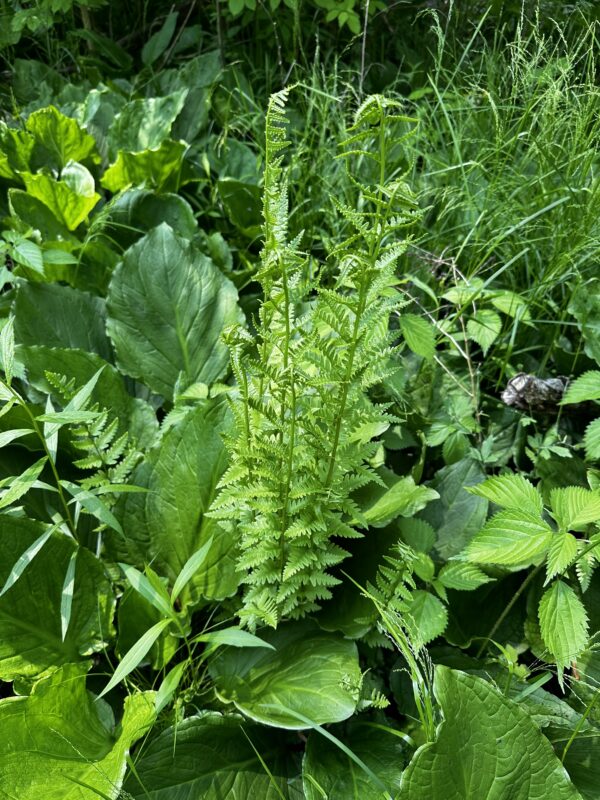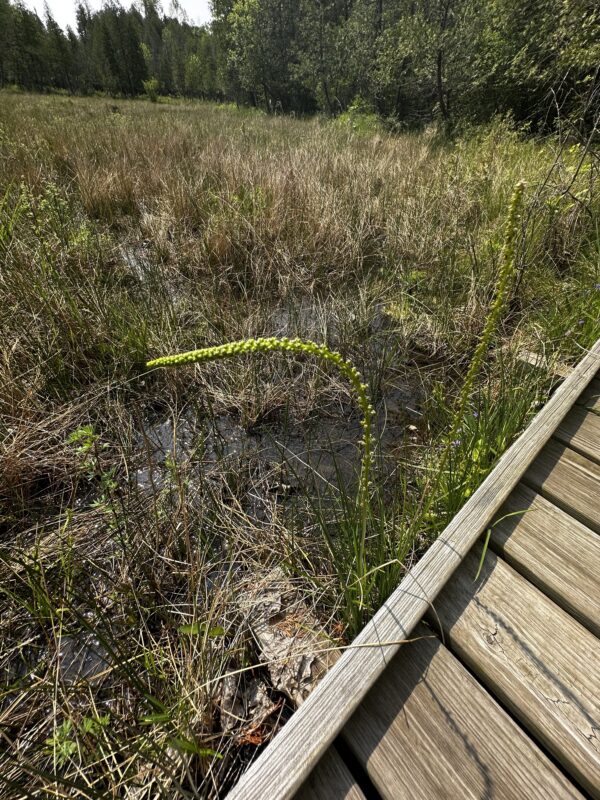Ecology of Cedar Bog (spoiler alert: it isn’t a bog!)
The easiest way to remember the difference between a bog and a fen? BOGS CLOG – FENS FLUSH! The inappropriately named Cedar Bog is actually a fen, because water that enters via precipitation, groundwater, and surface runoff drains the fen, “flushing” the system. This explains why the water in a fen is usually crystal clear — its constantly being filtered! This causes the cool, moist microclimate of Cedar Bog, which allows for some unique plants to be found here.
Inflorescence Types
Flowering Dogwood – Cornus florida
Flowering dogwood is a beautiful example of a compound cyme. Cornus florida can be identified by its simple, opposite leaves which have slightly wavy edges and are egg-shaped. The fruits of the flowering dogwood are a favorite of squirrels, deer, and even turkeys!

Marsh Arrowgrass – Triglochin palustris
Marsh arrowgrass is a wonderful example of a plant with a spike-like raceme inflorescence type. Triglochin palustris can be identifed by their flowers, which are globular to oblong-conical and contain a dense cluster of stigmas in the center. Marsh arrowgrass produces a pungent odor when crushed, and contains toxic amounts of cyanide.
Especially Conservative Plants of Cedar Bog
Shrubby Cinquefoil – Dasyphora fruticosa
Coefficient of Conservatism: 10

Swamp Birch – Betula pumila
Coefficient of Conservatism: 10

Clinton’s Wood Fern – Dryopteris clintoniana
Coefficient of Conservatism: 8

Prairie Valerian – Valeriana ciliata
Coefficient of Conservatism: 10
Unfortunately, this specimen was very far from the boardwalk. So this was the best picture I could get…

Black Ash vs. Green Ash (wait… aren’t they all green?)
Black Ash – Fraxinus nigra

Black ash trees, like all ashes, have pinnately compound, opposite leaves. Unlike other ashes, black ash leaflets are sessile! This characteristic makes them easily distinguishable from other ash species. In terms of color, black ash leaflets are yellow-green.
Green Ash – Fraxinus pennsylvanica

Green ash trees, of course, have pinnately compound and opposite leaves. Unlike the black ash, the green ash has leaflets that are stalked.
Floristic Quality of Cedar Bog’s Swamp Forests
The floristic index of a community can be calculated for a community using the equation:
Where I is the FQAI score, CC ᵢ is the coefficient of conservatism, and N is the number of native species occurring in the community being evaluated. Based on the species below, the FQAI of this community is 12.7.
Marsh Marigold – Caltha palustris
Wetland Status: OBL
Coefficient of Conservatism: 6
Virginia Iris – Iris virginica
Wetland Status: OBL
Coefficient of Conservatism: 6
Northern Spicebush – Lindera benzoin
Wetland Status: FACW-
Coefficient of Conservatism: 5
Golden Ragwort – Senecio aureus
Wetland Status: FACW
Coefficient of Conservatism: 4
Eastern Skunk Cabbage – Symplocarpus foetidus
Wetland Status: OBL
Coefficient of Conservatism: 6
Swamp Buttercup – Ranunculus septentrionalis
Wetland Status: FAC
Coefficient of Conservatism: 4
Floristic Quality of Cedar Bog’s Sedge Meadows
The floristic index of a community can be calculated for a community using the equation:
Where I is the FQAI score, CC ᵢ is the coefficient of conservatism, and N is the number of native species occurring in the community being evaluated. Based on the species below, the FQAI of this community is 21.2.
Shrubby Cinquefoil – Dasyphora fruticosa
Wetland Status: FACW
Coefficient of Conservatism: 10
Round-Leaved Sundew – Drosera rotundifolia
Wetland Status: OBL
Coefficient of Conservatism: 7
Swamp Birch – Betula pumila
Wetland Status: OBL
Coefficient of Conservatism: 10
Swamp Valerian – Valeriana uliginosa
Wetland Status: FACW+
Coefficient of Conservatism: 10
Poison Sumac – Toxicodendron vernix
Wetland Status: OBL
Coefficient of Conservatism: 7
Lesser Bladderwort – Utricularia minor
Wetland Status: OBL
Coefficient of Conservatism: 8

